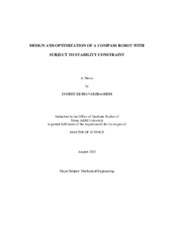| dc.description.abstract | In the first part of this thesis, the design of a compass robot is explored by considering its components and their interaction with each other. Three components including robot's structure, gear and motor are interacting during design process to achieve better performance, higher stability and lower cost. In addition, the modeling of the system is upgraded by considering the torque-velocity constraint in the motor. Adding this constraint of DC motor make the interaction of different components more complicated since it affects the gear and walking dynamics. After achieving the design method, different actuators (motor+ gear+ batteries) are selected for a given structure and the their performance is compared in the terms of cost, efficiency and their effect on the walking stability.
In the second part of the thesis, structural optimization of the compass robot with stability constraint is investigated. The stability of a compass robot as a hybrid system is analyzed by Poincare map. Including stability analysis in the optimization process, makes it very complicated. In addition, the objective function of the system has to be evaluated in the convergent limit cycle. Different methods are examined to solve this problem. Limit cycle convergence is the best solution among the existing methods. By adding convergence constraint to the optimization, in addition of making the stability analysis valid, it helps the optimization estimates the correct objective function in each iteration.
Finally, the optimization process is improved in two steps. The first step is using a predictive model in the optimization which covers the stable domain so that one does not need to check the stability of walking in each iteration. The Support Vector Domain Description (SVDD) approach which is applied to establish the stable domain, improve the decreases the optimization time. Another important step to upgrade the optimization is developing a computational algorithm which obtains the convergent limit cycle and its fixed-point in a short time. This algorithm speeds up the optimization time tremendously and allows the optimization search in a broader area. Combining SVDD approach in combination with Fixed-Point Finder Algorithm improve the optimization in the terms of time and broader area for search. | en |


